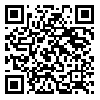Volume 27, Issue 7 (12-2019)
JSSU 2019, 27(7): 1747-1752 |
Back to browse issues page
Download citation:
BibTeX | RIS | EndNote | Medlars | ProCite | Reference Manager | RefWorks
Send citation to:



BibTeX | RIS | EndNote | Medlars | ProCite | Reference Manager | RefWorks
Send citation to:
Gavahi M, keyhan O, Abbaszadeh F. Relative Frequency of Temporomandibular Joint Disorder in the Patients with Mandibular Fracture in Yazd City during 2015-2017. JSSU 2019; 27 (7) :1747-1752
URL: http://jssu.ssu.ac.ir/article-1-4715-en.html
URL: http://jssu.ssu.ac.ir/article-1-4715-en.html
Abstract: (2458 Views)
Introduction: Temporomandibular joint disorder (TMD) has a high prevalence in societies, taking into account subclinical symptoms, which can affect significantly the quality of life of individuals. The history of trauma to the joint or chin includes events leading to TMD. The purpose of this study was to evaluate the relative frequency of TMD in the patients with mandibular fracture in Yazd city, Iran, during 2015-2017.
Methods: The present descriptive cross-sectional study examined the data of 295 patients with mandibular trauma that referred to trauma management centers in Yazd during 2015-2017. The patients' information was recorded in the questionnaires consisting age, gender, cause of trauma, type and location of fracture, type of treatment and type of TMD. Finally, data were analyzed by SPSS software version 17 using descriptive statistics, Chi-square and Fisher's exact tests.
Results: The study included 225 males and 70 females. The mean age of the patients was 25 years. In addition, the relative frequency of temporomandibular joint sounds and mandibular deviation in mouth opening was greater than other disorders.
Conclusion: Based on the results of this study, the mandibular fracture caused by traffic collision seems to increase the risk of TMD.
Methods: The present descriptive cross-sectional study examined the data of 295 patients with mandibular trauma that referred to trauma management centers in Yazd during 2015-2017. The patients' information was recorded in the questionnaires consisting age, gender, cause of trauma, type and location of fracture, type of treatment and type of TMD. Finally, data were analyzed by SPSS software version 17 using descriptive statistics, Chi-square and Fisher's exact tests.
Results: The study included 225 males and 70 females. The mean age of the patients was 25 years. In addition, the relative frequency of temporomandibular joint sounds and mandibular deviation in mouth opening was greater than other disorders.
Conclusion: Based on the results of this study, the mandibular fracture caused by traffic collision seems to increase the risk of TMD.
Type of Study: Original article |
Subject:
Surgery
Received: 2018/09/30 | Accepted: 2019/02/13 | Published: 2019/12/3
Received: 2018/09/30 | Accepted: 2019/02/13 | Published: 2019/12/3
Send email to the article author
| Rights and permissions | |
 |
This work is licensed under a Creative Commons Attribution-NonCommercial 4.0 International License. |







